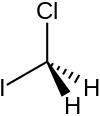


| |

| |
| Names | |
|---|---|
| Preferred IUPAC name
Chloro(iodo)methane | |
Other names
| |
| Identifiers | |
| |
3D model (JSmol) |
|
| 1730802 | |
| ChemSpider |
|
| ECHA InfoCard | 100.008.915 |
| EC Number |
|
PubChem CID |
|
| UNII | |
CompTox Dashboard (EPA) |
|
| |
| |
| Properties | |
| CH2ClI | |
| Molar mass | 176.38 g·mol−1 |
| Appearance | Colorless liquid |
| Density | 2.422 g mL−1 |
| Boiling point | 108 to 109 °C (226 to 228 °F; 381 to 382 K) |
Henry's law |
8.9 μmol Pa−1kg−1 |
Refractive index (nD) |
1.582 |
| Hazards | |
| GHS labelling: | |

| |
| Warning | |
| H315, H319, H335 | |
| P261, P305+P351+P338 | |
| NFPA 704 (fire diamond) | |
| Related compounds | |
Related alkanes |
|
Related compounds |
2-Chloroethanol |
Except where otherwise noted, data are given for materials in their standard state (at 25 °C [77 °F], 100 kPa). | |
Chloroiodomethane is the halomethane with the formula is CH
2ClI. It is a colorless liquid of use in organic synthesis.[1] Together with other iodomethanes, chloroiodomethane is produced by some microorganisms.[2]
Chloroiodomethane is used in cyclopropanation (Simmon-Smith reaction), where it often replaces diiodomethane because of higher yields and selectivity. It is also used in Mannich reaction, aminomethylation, epoxidation, ring opening and addition to terminal alkenes. It is a precursor to agent Ph3P=CHCl that can add a chloromethylene group (=CHCl).[1] It reacts with organolithium compounds to give chloromethyl lithium (ClCH2Li).[3]
It crystallizes orthorhombic crystal system with space group Pnma with lattice constants: a = 6.383, b = 6.706, c = 8.867 (.10−1nm).[4]
This article about an organic halide is a stub. You can help Wikipedia by expanding it. |